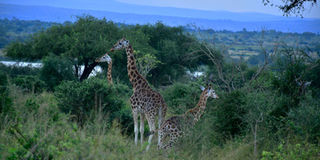For its demeanour, the giraffe needs protection

The gentle giants are a wildlife gem that ought to be protected. PHOTOS | EDGAR R BATTE
What you need to know:
- Conservation. To a tourist, giraffes are an attraction while the poacher looks at it as a source of meat and hide. Giraffes can be found in Kidepo Valley, Murchison Falls, Lake Mburo national parks and Pian Upe Reserve. Edgar R. Batte finds out why they should be protected.
- Kidepo Valley National Park is estimated to have 65 giraffes and Pian Upe 15. There is a stable increase in Lake Mburo from the original 15 translocated there. Giraffes are an attraction and there is no reason to end such precious life.
With its towering beauty, the giraffe is a wildlife gem. Gracefully, a giraffe manoeuvres through the savannah grasslands of Pian Upe Wildlife Reserve before a trio joins it. The three crane their necks to browse the shrubs and leaves off tree branches.
Tourists snap away.
For the tourist, giraffes are a must-see wild animal yet for the poacher, it is another animal whose meat and hide will fetch them a handsome price. That is bad news to conservationists who will do everything in their means to stop the poaching which affects tourism in Uganda whose rich and diverse wildlife makes it an enviable destination.
Why they are prized
Contextually, African Wildlife Foundation (AWF) observes that giraffe tails are highly prized by many African cultures and are used to make good luck bracelets, fly whisks, and even thread for stringing beads.
The world’s tallest land animal has lost 40 per cent of its population in just 30 years, and recent reports show poaching and wildlife trafficking are contributing to this decline. Giraffes are easily killed and poaching (now more often for their meat and hide) continues. As such, giraffes are faced mainly with poaching and habitat encroachment.

As an intervention, Uganda Wildlife Authority (UWA) has received support from the Giraffe Conservation Alliance (GCA)/Oregon Zoo Nature Connect to a tune of Shs30m as a part of solidarity funding towards giraffe monitoring efforts in Pian Upe Wildlife Reserve and Kidepo Valley National Park.
According to anti-poaching organisation, Big Life Foundation, giraffe meat can fetch up to $450 (about Sh1.7m).
“As UWA, one of the things we pride ourselves in is conservation and there are signs that our wildlife populations are growing. As that happens, we have issues with poaching; communities sometimes do not appreciate our work, therefore, we need to improve our ability to create awareness amongst the communities,” Sam Mwandha, the executive director of UWA explains.
Engage young people
Isaac Mujaasi, GCA project coordinator in East Africa, pledges to work closely with other partners to complement and tap into each other’s expertise to conserve wildlife resources for a global benefit.
“We believe that engaging young people who have not yet developed their morals is very important. Therefore, we are working towards strengthening wildlife and environmental clubs in schools and communities,” Mujaasi says.
Core in their focus, is developing environmental education packages that will enable young people to learn and take positive conservation actions at both the individual and community level.
With it, GCA envisages that awareness building, attitude and behavioural change to positive environmental actions are the most. In the areas surrounding Pian Upe and Kidepo, almost 80 per cent of the people live below the poverty line.
Mwandha says they have witnessed a spike in arrest of poachers. “We have continued with our work. Our staff that were originally into tourism, have been put into law enforcement so we do more patrols than before,” he adds.
He adds that UWA needs to improve its ability to monitor the animals for their health and safety from snares set by poachers.
“It is important that we have partnerships with individuals and organisations to give us support so the support from Giraffe Conservation Alliance has come at the right time because previously we were raising about $2m (over Sh7b) a month which has been going into our activities and infrastructure development,” Mwandha further explains.
According to the Giraffe Conservation Foundation (GCF), in the 1980s, the total number of giraffes in Africa was estimated at more than 155,000.
Meanwhile, Care for Karamoja is a conservation project aimed at improving the lives of endangered wildlife and over 785,000 food insecure people in the northeastern corner of Uganda. It was originally inspired by the plight of the Rothschild’s giraffes. It estimates that there are one million people living in Karamoja and almost 80 per cent of them are living below the poverty line and are therefore food insecure.
Mujaasi says young people need to be given opportunities such as hands-on experience on conservation projects and visits to conservation areas.
However, 85 per cent of the children have never been to the park with a perception that they are places for a white tourist. Equally, teachers in a radius of 40 to 75 kilometres from the park, have not visited either.
“We want to use that as an entry point in turning them into conservation ambassadors. Knowledge, awareness of issues to the need to do something,” he adds.
In 2017, the giraffe population was 880 which has risen to around 1,575, representing a stable population. Murchison Falls National Park has the biggest population.
Kidepo Valley National Park is estimated to have 65 giraffes and Pian Upe 15. There is a stable increase in Lake Mburo from the original 15 translocated there. Giraffes are an attraction and there is no reason to end such precious life.




